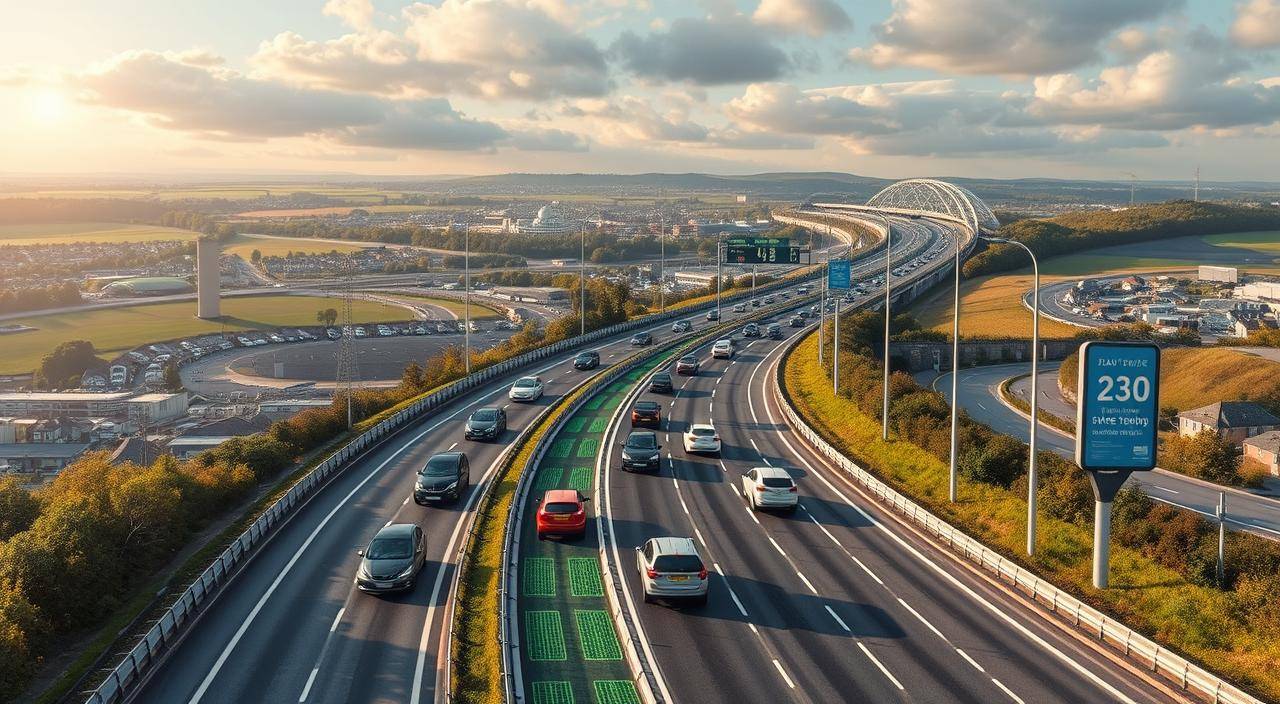UK Road Pricing: Infrastructure Tsar Urges Readiness
UK Road Pricing
Every morning, millions of people use Britain’s roads for work, fun, and moving goods. Our roads are key to our economy, connect our communities, and help us achieve our dreams. But, they need to be updated.
The infrastructure tsar says it’s time for change. They urge us to get ready for road pricing. This change is about making our roads sustainable for the future.
We must listen, learn, and lead in this change. The infrastructure tsar sees our roads as a chance for growth, not just problems. Road pricing is about changing how we travel, making it more efficient and green.
As we start this journey, we hear the call to prepare. The infrastructure tsar wants roads that do more than just carry us. They want roads that care for our planet and help our society thrive.
Key Takeaways
- Recognizing the necessity for the UK to be proactive in preparing for widespread road pricing.
- Understanding the infrastructure tsar’s call to action as a pivotal moment for road network evolution.
- Anticipating the impact of road pricing on the economy, the environment, and the fabric of daily life.
- Addressing the strategic need for ongoing dialogue, informed decision-making, and public engagement.
- Envisioning a future where UK road infrastructure acts as a cornerstone for sustainable development and innovation.
UK Must Prepare for Widespread Road Pricing, Says Infrastructure Tsar
The UK is moving fast towards electric cars. This means we need to prepare for UK road pricing more than ever. The change from petrol and diesel to electric cars will cut down on tax money. Right now, fuel duty and vehicle excise duty bring in about £35bn a year.
By 2045, electric cars will be everywhere. This will lead to a big drop in tax money. To make up for this, introducing widespread road pricing in the UK is seen as a good idea. Rates could be between 33% to 39%.
But, the Treasury is still figuring out how to make it work. They need to come up with a solid plan quickly. This is because the current system is not working well.
The National Infrastructure and Service Transformation Authority (Nesta) will start next year. It will lead big projects like the Lower Thames Crossing. This project has a big budget of £9bn but is facing delays.
The government wants to save money by fixing old projects. They hope to save between £1bn and £2bn every year until the 2030s. This will help pay for road pricing systems.
To prepare for road pricing, In a bold assertion, an influential infrastructure tsar has emphasized that the UK must prepare for widespread road pricing, highlighting the urgent necessity to adjust to changing transportation dynamics. As the cost of maintaining roads continues to rise and traditional funding methods face increasing scrutiny, the implementation of a fair and effective pricing model could serve as a viable solution. Widespread road pricing in the UK could not only generate essential revenue but also encourage a shift towards sustainable transportation options, ultimately reducing congestion and emissions.
However, the challenge lies in developing a system that is equitable and considers the diverse needs of the population. The focus must be on technological advancements that enable easy tracking and billing, without infringing on individual privacy. Communicating openly with the public about the benefits and impact of such a system is critical; after all, successful road pricing must resonate with people’s values and be perceived as a necessary investment in the future.
In the face of impending infrastructure demands, failure to initiate discussions around widespread road pricing in the UK could lead to a variety of negative consequences, including deteriorating transport networks and increased financial strain on public services. By proactively addressing these issues now, policymakers can better shape the future of Britain’s road systems, ensuring they remain efficient and resilient. The infrastructure tsar’s call to action is not just about implementing a pricing model; it signifies a larger movement towards reimagining urban transport in a way that benefits both the economy and the environment.
Ultimately, the time to act is now. As the conversation around widespread road pricing gains momentum, stakeholders from local communities to industry representatives must engage in this critical dialogue. Through careful planning and collaboration, the UK can transition to a road pricing system that not only fills the fiscal gaps but also paves the way for a more sustainable and equitable transportation future.
we need to plan carefully. We must find a way to fill the tax gap without hurting people. This will need new technology and fair policies that listen to everyone.
The ban on new petrol and diesel cars is coming in 2035. We don’t have much time to get a fair road pricing system ready.
| Key Parameter | Current Status | Projected Impact |
|---|---|---|
| Tax Revenue from Fuel Duty | £35bn Annually | Sharp Decline Post-2045 |
| Vehicle Electrification by 2045 | Almost 100% | Major Revenue Shortfall |
| Road Pricing Test Rates | 33% to 39% | Under Discussion |
| Infrastructure Savings Target | £1bn to £2bn Yearly Until 2030s | Enhanced Economic Flexibility |
As we prepare for widespread road pricing in the UK, we must make sure it fits well with our transport and economy. We also need to talk to the public and explain the changes. The UK’s roads are about to change a lot, and we need to be ready.
The Current State of UK Road Infrastructure
The UK road infrastructure is key to the country’s economy. It helps move goods and people around. But, it’s under strain from more traffic. This makes the infrastructure tsar‘s job crucial in upgrading and using roads wisely.
Now, road pricing UK ideas are being looked at. It’s vital to check how roads are working. This helps figure out where to use pricing fairly and well.The state of road infrastructure in the UK has become a critical topic of discussion among policymakers and the public alike. Recent assessments indicate that while the road network is extensive, it is facing significant challenges due to increased traffic volumes, aging infrastructure, and insufficient maintenance funding. The Government’s infrastructure tsar has highlighted the urgent need for investment not just in keeping roads in good repair but also in ensuring they can handle future demands linked to urbanization and environmental goals. With climate change becoming an ever-pressing concern, sustainable road use planning is more crucial than ever.
As discussions around road efficiency increase, authorities are considering various models of road pricing in the UK. This approach aims to alleviate congestion and encourage more responsible use of road resources. The idea of widespread road pricing UK has gained traction as a means of funding essential upgrades while also managing the current strain on the transportation network. By implementing a system that charges drivers based on factors such as distance traveled and peak usage times, the argument goes that road wear can be mitigated, and funds can be earmarked for necessary projects.
However, the concept of road pricing presents its own set of challenges and controversy. Critics argue that it could disproportionately affect lower-income drivers who may rely on cars for their daily commutes. Proponents, however, emphasize that a fair and well-structured pricing model could drive investment in public transport alternatives, ultimately leading to a more balanced and equitable transport system. Finding a middle ground that takes into account the diverse needs of the UK populace while also addressing the demands on our roadways will be essential for successful policy implementation.
In conclusion, the conversation around the UK’s road infrastructure is evolving rapidly as we seek solutions that align with future mobility needs. As the infrastructure tsar continues to advocate for a renewed focus on both investment and innovative pricing strategies, it becomes increasingly clear that a multifaceted approach is necessary. Only by embracing change and adopting new ideas can we ensure that our roads are not only well-maintained but also intelligently utilized for years to come.
The Efficacy of Existing Road Networks
Roads in the UK vary in how well they handle traffic. Cities often get stuck in traffic, hurting the economy and polluting. The infrastructure tsar suggests investing in these areas. This could ease congestion and make roads better.
Challenges Facing UK Road Infrastructure
The UK’s roads face big problems. They’re old, maintenance costs are high, and they need to keep up with new tech like electric cars. Road pricing UK could help manage traffic and fund repairs.
Introducing Road Pricing in the UK: Benefits and Challenges
The idea of widespread road pricing in the UK is a hot topic. It brings up both the good and the bad sides of road pricing benefits and road pricing challenges. If done right, it could change how we move around cities, making them better for everyone.
Road pricing aims to cut down on traffic jams and pollution. It offers solutions that change with traffic, encouraging people to use public transport or travel at less busy times. This not only helps manage traffic but also raises money for better public transport.
- Enhanced traffic management
- Promotion of environmental sustainability
- Financial support for infrastructure development
But, there are also big hurdles to overcome. People worry about privacy, fairness, and how it affects their daily commute. To tackle these road pricing challenges, it’s key to be open, fair, and use the latest tech to keep things private and secure.
| Benefit | Challenge |
|---|---|
| Effectively reduces traffic congestion | Public opposition due to perceived fairness |
| Generates revenue for public transport improvements | Complexity of system implementation and maintenance |
| Encourages use of greener modes of transport | Concerns about privacy with tracking systems |
In summary, widespread road pricing in the UK has big pluses like helping finance roads and being good for the environment. But, it also raises important questions about money and society that need careful thought.
The Role of the Infrastructure Tsar in UK’s Road Pricing Strategy
In the UK, the infrastructure tsar is key in shaping transport policies, especially road pricing. They guide policy and make sure it fits with national goals. This is crucial for the country’s transport future.
The tsar’s job is to help make road pricing clear and work well. They use their knowledge to solve problems that might come up when introducing new charges for roads.
Advisory and Oversight Functions
The tsar gives advice on the technical, economic, and social sides of road pricing. They look at different pricing models and how they affect traffic, the environment, and the economy. They also check if the prices are fair.
They make sure the system is set up right, avoiding mistakes of the past. This is important to make sure everything runs smoothly.
Strategic Planning and Implementation
The tsar works with many groups to create a plan for road pricing. They aim to meet public needs and follow the law. This plan must be practical and work for the future of cities.
The tsar’s role goes beyond just planning. They help make the plan real by working on the details of the system. This shows how important they are for making road pricing work in the UK.
As the UK improves its road pricing, the tsar’s role is more crucial than ever. They help balance policy with public needs. Their work is key to a better, greener transport system for the UK.
Financial Implications of Road Pricing on the UK Economy
The UK is introducing road pricing, which will change the economy a lot. It will affect how much money the government makes and spends. This change is part of moving towards greener transport, showing the need to grasp the road pricing economic impact.
One big reason for road pricing is the drop in tax money from electric cars. Now, car and fuel taxes bring in about £35 billion a year. But, as electric cars become more popular, this money will start to go down.
Introducing road pricing is seen as a way to make up for this lost money. It could also help control traffic better, saving a lot on building roads. These savings are key, especially when looking at the cost of big projects like HS2, which is very expensive.
| Financial Aspect | Impact |
|---|---|
| Shortfall from EV transition | £35 billion potential loss in tax revenue |
| Annual revenue from duties | £35 billion from vehicle and fuel duties |
| Savings from efficient management | £1-2 billion annually |
| Cost of HS2 per kilometer | £145 million |
The link between the UK economy and road pricing is clear. Road pricing does more than just balance the books. It changes the economic plan towards a greener future. It’s up to policymakers to make sure road pricing helps the economy grow and protects the environment.
Road pricing could help the economy by saving money and making roads better. It’s crucial for the UK’s economic future. So, understanding the road pricing economic impact is key for a sustainable economy.
Public Perception and Potential Resistance to Road Pricing
In the UK, how people see road pricing is key to its success. With many differing views, it’s vital to look closely at what people think. We must also tackle the main worries they have.
Understanding the Public Sentiment
Opinions on road pricing are mixed. Some see the good sides, like less traffic and cleaner air. But many worry about the cost and privacy issues. To really understand what people think, we need to keep talking through surveys and forums.
Addressing Concerns and Misconceptions
To fight back against road pricing worries, clear talk and smart planning are essential. We must show why these systems are needed and how they help. Telling people how the money from road pricing will be used can help ease financial fears.
It’s also important to teach people the truth about road pricing. We need to make sure they know how it works and that their privacy is safe.
- Community meetings to gather feedback and generate dialogue around road pricing implementations.
- Detailed FAQs and informational brochures distributed both online and in community centers.
- Engaging social media campaigns to reach a broader audience and encourage public interaction.
Getting to grips with these points is vital. It helps reduce opposition and builds support for road pricing in the UK.
Technological Requirements for Implementing Road Pricing
The success of road pricing in the UK depends on advanced technologies. These must manage and enforce pricing well. They also need to make using the roads easy and fair.
Innovations in Road Pricing Systems
New ideas in road pricing are key. They help make systems efficient and easy to use. For example, dynamic pricing adjusts to traffic in real time.
Also, new ways to detect and bill vehicles are being developed. These help keep traffic moving and reduce jams.
Machine learning can also predict traffic and change prices. This discourages driving during busy times without hurting the economy. Such tech makes road pricing more effective and popular.
Integrating Technology for Effective Management
To work well, road pricing technology must fit with current systems. This means adding new sensors and cameras to roads. It also means making sure different payment methods work together smoothly.
Handling and keeping data safe is also crucial. With lots of transactions, strong systems are needed. This keeps users’ information secure and builds trust in the system.
In summary, to succeed, we need to keep improving technological requirements for road pricing. This includes road pricing system innovation and road pricing technology integration. These efforts will help reduce traffic and make cities better places to live in the UK.
Comparative Analysis: International Examples of Road Pricing
Looking at international road pricing examples gives us valuable insights. It shows how different countries manage traffic and make money. The UK can learn from their successes and challenges to create better global road pricing strategies.
Each country has its own way of pricing roads, based on their economy and society. Singapore uses an Electronic Road Pricing system to control traffic. On the other hand, cities like Stockholm and London have congestion charges to reduce traffic and pollution.
To understand these systems better, let’s look at a table. It shows how countries have set up road pricing, the problems they faced, and the benefits they got:
| Country | System Type | Key Benefits | Challenges Overcome |
|---|---|---|---|
| Singapore | Electronic Road Pricing (ERP) | Effective congestion control, revenue for infrastructure | Public acceptance, technology adoption |
| Germany | Lorry Toll | Road maintenance funding, eco-friendly transport incentives | Logistical implementation, EU regulations adherence |
| Norway | Automatic Tolling | Infrastructure development, reduced traffic | Privacy concerns, system integration |
| United States | Variable-pricing Toll Lanes | Traffic management flexibility, targeted financial gains | Scaling infrastructure, variable demand management |
Different countries show that there’s no single solution for road pricing. By learning from international road pricing examples and creating global road pricing strategies for the UK, we can make our system better. This cross-jurisdictional learning is key to planning and implementing road pricing that meets national goals and public needs.
Conclusion
The UK is on the brink of a big change in how it handles transport costs. The idea of introducing UK road pricing is now a real plan. The guidance from the infrastructure tsar has shown us how complex this change will be.
It will need a mix of new technology, public support, and smart economic plans. This mix will help shape a future road strategy that meets the needs of today’s society. It will be modern, dynamic, and focused on the environment.
But, setting up a road pricing system won’t be easy. It needs to balance new ideas with what works in practice. The tsar’s advice helps us find this balance, making sure our transport system is strong, flexible, and fair.
The success of UK road pricing depends on people agreeing with it and following the tsar’s advice. As we move forward, our planning and action will show if our roads can be sustainable. The goal is clear: to create a road strategy that boosts the economy, protects the environment, and benefits everyone.
This vision will lead the UK in transport innovation and keep it ahead in global infrastructure. It’s a big challenge, but with everyone’s help, we can achieve it.
FAQ
Why does the UK need to prepare for widespread road pricing?
The UK is looking at new ways to fund its roads because cars are now more fuel efficient. This means less money from fuel duty. Road pricing is seen as a solution to keep our roads in good shape.
It’s important to get ready for road pricing. This will help our transport network stay strong. It will also help manage traffic better.
What role does the infrastructure tsar play in the UK’s road pricing strategy?
The infrastructure tsar gives advice on road pricing in the UK. They look at the financial health of our roads. They also suggest tech solutions and make sure road pricing fits with national goals.
What are the benefits of introducing road pricing in the UK?
Road pricing can reduce traffic jams. It encourages cleaner transport, which is better for the environment. It also provides a steady income for road upkeep.
What challenges might the UK face with the implementation of road pricing?
The UK might struggle to get people to accept road pricing. It’s complex to set up and needs to be fair. There are also worries about privacy and the cost to users.
Businesses and commuters might be affected too. The system needs to be reliable and secure.
How will road pricing affect the UK economy?
Road pricing could change how we invest in transport. It might bring in more money. But, we need to think about how it will affect people and the economy.
What is the public perception towards road pricing in the UK?
People have mixed views on road pricing. Some worry about the cost, privacy, and fairness. It’s important to talk about these concerns to win public trust.
What technological advancements are necessary for road pricing implementation?
We need good technology for road pricing to work. This includes GPS, mobile apps, and secure payment systems. The tech must be reliable and easy to use.
How do international examples inform the UK’s approach to road pricing?
The UK can learn from other countries with road pricing. They can share how to make it work and what challenges to expect. This helps the UK make better decisions about its own road pricing.










1 comment